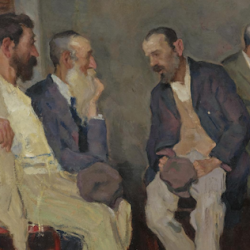Ernest Simmons’s The Entangled Trinity is an effort to work out the relation of theology and science through Trinitarian theology, and particularly through the concept of perichoresis, which leads into a panentheistic understanding of God’s relation to the world.
He uses the metaphor of “complementarity” the quantum idea that what we find in phenomena depends on what we’re looking for and how we look. “Measurement (observation) determines whether we derive a wave or a particle” (152).
This leads him to a discussion of perichoresis: “When we look for origins, we find Creator. But we are not always looking for origins. Sometimes we are looking for forgiveness and for hope. We are looking for ‘good news’ (gospel), and the early Christian community found this present in Jesus as the Christ, the anointed one of God. If the divine is entangled, that is, interrelated and interdependent with multiple potentials such as a wave function, then the same entangled divine reality can be experienced as incarnation, not just origination. The two are superimposed on one divine reality. Finally, the community also experienced, within the community itself, the sustaining spirit, the ‘Comforter,’ the ‘creative Spirit,’ as the ongoing presence of the divine within the midst of the community. This too is an expression of divine entanglement whereby a different experience is called on as the basis for reflection on the divine, another expression of divine relatedness” (152-3). In all these, “the same God” was at work.
Should this sound modalist, or sound as if the early church was projecting experience onto the blank surface of divinity, Simmons summons the notion of “superposition” to explain relation of the immanent and economic Trinity: “Much like a particular is within the wave function in its potentiality [and must be excited by energy]. the economic Trinity is superimposed on the eternal potentiality of the immanent Trinity and emerges in particular in relationship to the creation. The immanent Trinity is the eternal potentially of the divine for multiple forms of relatedness and experience by humanity and the wider creation.” We find what we’re seeking in God because the God we find is “the simultaneous entanglement of the divine love.” Simmons doesn’t think we find everything we might seek in God, or that we create God; rather, “the divine reality expresses itself in multiple ways, which humanity is only occasionally able to discern from diverse, finite perspectives” (153). In sum, perichoresis is “the mutual indwelling energy of the divine Trinity through which the creation is created and which evolves within the life of God as entangled superposition” (153).
From within this eternal entanglement of love, God creates, and of course creates a world of relationship, a world entangled. God and the world are in real, panentheistic relationship. God is not identical to the world; He limits Himself to give the world real freedom. Simmons argues that creation affects God just as God affects creatures. This doesn’t entail that God is dependent on the world, at least for His existence. Simmons quotes Philip Clayton’s remark that “It is sufficient for God to be internally related in order for God to exist, but no finite creature exists as result of being internally related” (161).
There’s much to like here. Simmons emphasizes that God’s transcendence is not at odds with His near presence, but that transcendence and immanence presuppose one another (158). The relationship between God and the world is real on both ends, but it is not symmetrical. To the extent that panentheism means that the creation exists in God and God in the creation, it is a sound description of the God-world relation.
Yet, Simmons leaves some big questions unanswered. He could have acknowledged the limits of his scientific metaphors more openly, and should have answered obvious classic questions like: What can it mean to speak of “potential” in God? In what way is God “affected” by the creation? There appear to be some internal contradictions in his formulation: If God is the energy that moves creation toward its climax, where is the space of freedom? More fundamentally, can Simmons maintain his emphasis on God’s transcendence while also speaking of kenotic self-limitation? If transcendence is what he says it is, why do we need kenosis in any case?













